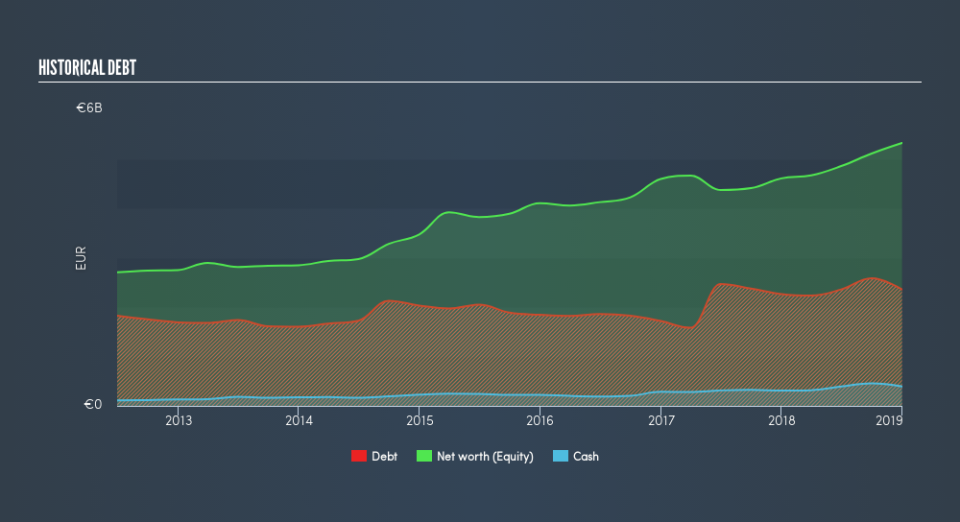Is Hexagon AB (publ) (STO:HEXA B) A Financially Sound Company?

There are a number of reasons that attract investors towards large-cap companies such as Hexagon AB (publ) (STO:HEXA B), with a market cap of kr189b. Big corporations are much sought after by risk-averse investors who find diversified revenue streams and strong capital returns attractive. But, the health of the financials determines whether the company continues to succeed. This article will examine Hexagon’s financial liquidity and debt levels to get an idea of whether the company can deal with cyclical downturns and maintain funds to accommodate strategic spending for future growth. Remember this is a very top-level look that focuses exclusively on financial health, so I recommend a deeper analysis into HEXA B here.
See our latest analysis for Hexagon
Does HEXA B Produce Much Cash Relative To Its Debt?
Over the past year, HEXA B has maintained its debt levels at around €2.4b including long-term debt. At this current level of debt, HEXA B's cash and short-term investments stands at €395m , ready to be used for running the business. Additionally, HEXA B has generated €952m in operating cash flow during the same period of time, resulting in an operating cash to total debt ratio of 40%, meaning that HEXA B’s current level of operating cash is high enough to cover debt.
Can HEXA B meet its short-term obligations with the cash in hand?
With current liabilities at €1.8b, it seems that the business has been able to meet these commitments with a current assets level of €2.1b, leading to a 1.13x current account ratio. The current ratio is the number you get when you divide current assets by current liabilities. Usually, for Electronic companies, this is a suitable ratio as there's enough of a cash buffer without holding too much capital in low return investments.
Does HEXA B face the risk of succumbing to its debt-load?
With a debt-to-equity ratio of 44%, HEXA B can be considered as an above-average leveraged company. This isn’t uncommon for large companies because interest payments on debt are tax deductible, meaning debt can be a cheaper source of capital than equity. Since large-caps are seen as safer than their smaller constituents, they tend to enjoy lower cost of capital. We can assess the sustainability of HEXA B’s debt levels to the test by looking at how well interest payments are covered by earnings. Net interest should be covered by earnings before interest and tax (EBIT) by at least three times to be safe. For HEXA B, the ratio of 82.26x suggests that interest is comfortably covered. High interest coverage is seen as a responsible and safe practice, which highlights why most investors believe large-caps such as HEXA B is a safe investment.
Next Steps:
HEXA B’s high cash coverage means that, although its debt levels are high, the company is able to utilise its borrowings efficiently in order to generate cash flow. This may mean this is an optimal capital structure for the business, given that it is also meeting its short-term commitment. This is only a rough assessment of financial health, and I'm sure HEXA B has company-specific issues impacting its capital structure decisions. I recommend you continue to research Hexagon to get a more holistic view of the large-cap by looking at:
Future Outlook: What are well-informed industry analysts predicting for HEXA B’s future growth? Take a look at our free research report of analyst consensus for HEXA B’s outlook.
Valuation: What is HEXA B worth today? Is the stock undervalued, even when its growth outlook is factored into its intrinsic value? The intrinsic value infographic in our free research report helps visualize whether HEXA B is currently mispriced by the market.
Other High-Performing Stocks: Are there other stocks that provide better prospects with proven track records? Explore our free list of these great stocks here.
We aim to bring you long-term focused research analysis driven by fundamental data. Note that our analysis may not factor in the latest price-sensitive company announcements or qualitative material.
If you spot an error that warrants correction, please contact the editor at editorial-team@simplywallst.com. This article by Simply Wall St is general in nature. It does not constitute a recommendation to buy or sell any stock, and does not take account of your objectives, or your financial situation. Simply Wall St has no position in the stocks mentioned. Thank you for reading.


